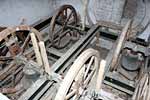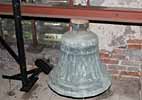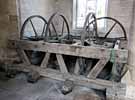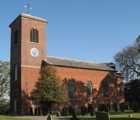For this church:    |
|
| Inscription | Size | |
| 1 | A. Burgin T. Pockington Churchwardens Edw. Arnold Leicester fecit 1794 |
2 ft. 4 ins |
| 2 | A. Burgin T. Pockington Churchwardens Edw. Arnold Leicester fecit 1794 |
2 ft. 5 ins. |
| 3 | A. Burgin T. Pockington Churchwardens Edw. Arnold Leicester fecit 1794 |
2 ft. 6 ins. |
| 4 | A. Burgin T. Pockington Churchwardens Edw. Arnold Leicester fecit 1794 |
2 ft. 8 ins |
| 5 | A. Burgin T. Pockington Churchwardens Edw. Arnold Leicester fecit 1794 |
2 ft. 10 ins. |
They were originally hung in a wooden frame, Elphick type Z, dating from 1793-4. This frame was carefully dismantled and has been re-erected in the north aisle at Saundby church.
The bells were rung from a ringing chamber above the porch, from which it and the gallery are approached by a staircase. The structure of the church could not support the bells being rung, and severe cracking resulted. Metal ties were installed to brace the structure, with limited success.
Between 1980 and 1982 the church petitioned for a new bell frame to be built. In 1984 the bell frame was replaced by a new steel frame by Eayre and Smith of Melbourne, Derbyshire.
In 1986 a new set of bells was installed. They were small and so quiet that microphones had to be installed so that people could hear them. Dawson (1994-5) provides information on the fate of the original bells:
'When the new bells were installed in 1986 several of the old bells were not scrapped but were sold to other churches. The treble is now the treble of 6 at High Halstow, Kent; the 2nd is the treble of 6 at nearby Hickling; and the 3rd is the treble of 5 at Woodborough.'
 The 1984 bell frame The 1984 bell frame |
 Service bell Service bell |
 Seliok maker's marks on Seliok maker's marks onthe service bell |
 The 1793-4 bell frame The 1793-4 bell framenow at Saundby church |
By 2010 there were six additional bells at St Luke, making 12 in total, plus a service bell. All of the bells date from 1927 except for the service bell, originally the treble of four at Bassingthorpe in Lincolnshire, which is the work of the Seliok family c.1520.






